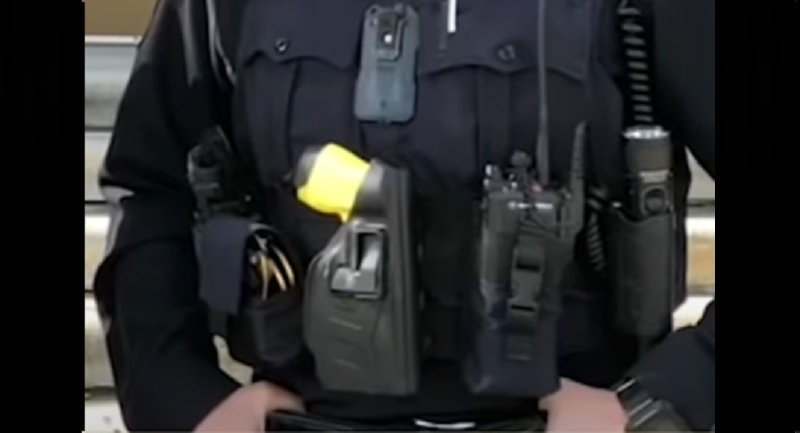
There are two items that were added to my duty belt during my career for which I was very grateful. One was pepper spray, the other was a TASER. Before that, the only tools I had were my revolver, my nightstick, tear gas spray, and my hands.
There are limitations with every weapon that is designed to protect the officer and bystanders from a resisting suspect, and to coerce compliance when someone would rather fight than lawfully submit to an arrest as the statutes require. The firearm obviously is the most lethal and reserved for those times when a suspect presents an imminent threat of death or serious injury.
The baton (nightstick) can be used to strike locations on the body that can stun and temporarily slow or disable an adversary’s movements, or cause them to drop a weapon. A baton can also be used to lock up joints for escorting an arrestee more safely using the added leverage from the device. Modern versions of the baton are expandable to fit more easily on the tool belt and have the added benefit of a dramatic presentation that gives a clear warning to the suspect that they have chosen to elevate the situation.
The limits of the baton are that an officer has to be dangerously close to a resisting subject in order to apply the techniques of control effectively. Another is that the officer must be as careful as possible in the middle of a scuffle to avoid doing serious injury to the neck, head, and joints, which are “red zones” in training that the officer is taught are not appropriate targets. Another risk, as with all of the officer’s equipment, is that if the baton is taken from the officer, the offender will have no such restraint in using it to assault and escape.
The old tear gas, before pepper spray came around, popularly called Mace after a brand name that became a generic term, could be effective if used in the right circumstances. Officers had to know which way the wind was blowing to avoid getting sprayed themselves and had to be aware of the location of other officers who might get doused. Tear gas is made of small particulates suspended in a liquid under pressure. For the substance to be effective, the spray was aimed at the chest so that the irritant would waft its way up into the mouth, nose, and eyes as an irritant that caused pain and distraction.
While it often took the fight out of a person, the dried remains of the irritant easily contaminated everyone in the area and anyone who had subsequent contact with the arrested person against whom it had been applied. Nearly every officer ended up teary-eyed to some degree. It also took a few moments for its effects to be felt by a suspect, particularly one less sensitive to pain in the middle of the adrenaline rush of fighting. That gave the suspect too much time to keep resisting.
When OC spray (oleoresin capsicum), better known as pepper spray from the main irritating ingredient, came along after the FBI studied and approved it, there were several advantages. One is that OC is not just an irritant but constricts the airway and eyes creating a virtually instant focus of the arrestee on breathing and pain. Many suspects have continued to fight through an OC application, but less effectively. OC, unlike tear gas, is applied directly to the face and is stickier and less likely to spread to bystanders and other officers, although it often affects the users as well.
Of course, officers must retain possession and not let any of their weapons, including the less lethal ones, be used against them. This is especially true of the TASER.
Electronic Control Weapons (ECW), the market for which is dominated by the name brand TASER, operates by administering a surge of electric current that is the same frequency as the human nervous system. This essentially locks the body’s muscles, causing the person to become rigid and immobile. Although many believe that the effect of an ECW is to cause pain and therefore compel compliance, pain is merely a byproduct of the ECW.
The trained ECW user knows that the barbed wires that are shot from the often pistol-shaped weapon must have a certain spread from one another for an effective shock to be delivered. This means that very close shots can be ineffective and merely cause pain rather than immobilizing a suspect and that heavy clothing can interfere with the barbs. The professional user also fastidiously avoids the head and neck as targets, limits the length of the shock application, gets control of the suspect, and renders aid quickly.
Police have been criticized for using the firearm as a defense against a person who has gained control or is attempting to gain control of the officer’s TASER, reasoning that it isn’t a fair fight to use lethal force against a tool that is specifically designed to be less lethal. The same arguments can be made for a suspect’s control of a baton or OC. One of the reasons officers are trained to maintain distance during a contact is to increase their ability to keep control of the equipment on their person.
But if a resisting suspect gains control of an ECW, the officer is at great risk. The criminal will give no consideration to the restraint that a trained user must use. For an officer to be immobilized, blinded, or given painful shocks, puts them in a deadly confrontation of vulnerability where deadly force remains their only option for survival. Critics ignore the fact that once immobilized or seriously distracted, an officer can end up losing their other weapons and equipment which can also be used against them or other citizens.